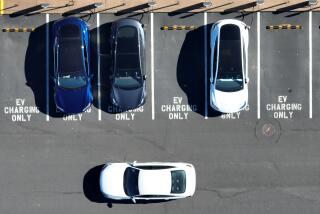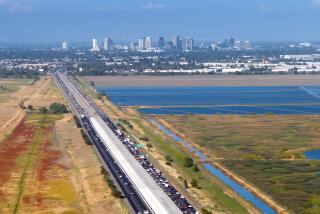A Worthy Transportation Plan
- Share via
The state of California can never build enough freeways to get 30 million Californians wherever they want to go at the beginning of the 21st Century. But with enough money, brains, technology, planning and creativity, the state can develop a modern transportation system that will keep the state’s economic engine running strongly and maintain the basic life style that makes California the Golden State.
The foundation of such a program is on the table in Sacramento, close to final agreement between Gov. George Deukmejian and state legislative leaders. They must settle the remaining loose ends soon and seal the deal. Then, they must work with the business community to persuade California voters that the $18.5-billion transportation finance plan is essential if the state is to control its own destiny. The option is increasing, paralyzing gridlock, leading to a certain undermining of the state’s economy.
Representatives of the governor and legislative leaders reached tentative agreement Tuesday on the program to be financed by a 9-cent-per-gallon increase in the gasoline tax over five years and significant increases in truck fees. The money would go toward a mix of new highway construction and maintenance, mass transit facilities, local roads, congestion relief, modern traffic management techniques and environmental enhancement projects like sound barriers and tree-planting.
Significantly, the plan also would include a growth-management segment patterned after one approved by voters in Contra Costa County last year. This would require local regions to develop plans for accommodating growth as a condition of receiving new state aid. Growth management is an essential element in the package since transportation routing has such a dramatic effect on growth, and unplanned development can quickly clog existing streets and roads.
The next step is for negotiators to approve a modest liberalization of the Gann spending limits so that the new transportation money can be allocated. It also would give California a more realistic cap on overall spending. The Gann change would require a vote of the people either at a special election this fall or at the primary next June and would, in effect, serve as a referendum on the gasoline tax increase.
Both the governor, who previously opposed gas tax increases, and legislators deserve credit for developing the program, which incorporates most of the elements of a forward-looking plan sponsored by Assemblyman Richard Katz (D-Sylmar), chairman of the Assembly Transportation Committee. The energy of state Transportation Director Robert K. Best also was essential to the process.
This transportation finance program is critical to California’s future. It cannot be allowed to fail.
More to Read
Get the L.A. Times Politics newsletter
Deeply reported insights into legislation, politics and policy from Sacramento, Washington and beyond. In your inbox three times per week.
You may occasionally receive promotional content from the Los Angeles Times.










